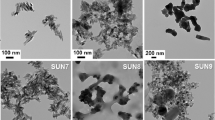Abstract
Nanosized TiO2 particles (nTiO2) are usually coated with an Al(OH)3 layer when used in sunscreen to shield against the harmful effects of free radicals that are generated when these particles are exposed to UV radiation. Therefore, it is vital to insure the structural stability of these particles in the environment where the protective layer may be damaged and adverse health and environmental effects can occur. This study utilized X-ray analysis (SEM–EDS) to provide a qualitative and semi-quantitative assessment of the chemical and physical characteristics of Al(OH)3-coated original and damaged nTiO2 particles (used in sunscreen lotion formulations) in the presence of both swimming pool and seawater. Also, by utilizing statistical tools, a distribution of Al/Ti (%) on the particle surface was determined and evaluated. It was found that 45 min of treatment with swimming pool and seawater significantly induced the redistribution of Al/Ti (%), which changed the surface characteristics of particles and, therefore, may have induced undesired photo-activity and the consequent formation of free radicals.






Similar content being viewed by others
References
Anipsitakis GP, Tufano TP, Dionysiou DD (2008) Chemical and microbial decontamination of pool water using activated potassium peroxymonosulfate. Water Res 42(12):2899–2910. doi:10.1016/j.watres.2008.03.002
Auffan M, Pedeutour M, Rose J, Masion A, Ziarelli F, Borschneck D, Chaneac C, Botta C, Chaurand P, Labille J, Bottero JY (2010) Structural degradation at the surface of a TiO2-based nanomaterial used in cosmetics. Environ Sci Technol 44(7):2689–2694
Brezová V, Gabcová S, Dvoranová D, Stasko A (2005) Reactive oxygen species produced upon photoexcitation of sunscreens containing titanium dioxide (an EPR study). J Photochem Photobiol B 79(2):121–134. doi:10.1016/j.jphotobiol.2004.12.006
Buchalska M, Kras G, Oszajca M, Lasocha W, Macyk W (2010) Singlet oxygen generation in the presence of titanium dioxide materials used as sunscreens in suntan lotions. J Photochem Photobiol A 213(2–3):158–163. doi:10.1016/j.jphotochem.2010.05.019
Chen X, Mao SS (2007) Titanium dioxide nanomaterials: synthesis, properties, modifications, and applications. Chem Rev 107(7):2891–2959. doi:10.1021/cr0500535
Conner TL, Williams RW (2004) Identification of possible sources of particulate matter in the personal cloud using SEM/EDX. Atmos Environ 38(31):5305–5310. doi:10.1016/j.atmosenv.2004.06.005
Fay F, Linossier I, Langlois V, Haras D, Vallee-Rehel K (2005) SEM and EDX analysis: two powerful techniques for the study of antifouling paints. Prog Org Coat 54(3):216–223. doi:10.1016/j.porgcoat.2005.05.005
Kanaya K, Okayama S (1972) Penetration and energy-loss theory of electrons in solid targets. J Phys D 5(1):43
Kester DR, Duedall IW, Connors DN, Pytkowicz RM (1967) Preparation of artificial seawater. Limnol Oceanogr 12:176–179
Kruskal W, Wallis WA (1952) Use of ranks in one-criterion variance analysis. J Am Stat Assoc 47(260):583–621
Labille J, Feng J, Botta C, Borschneck D, Sammut M, Cabie M, Auffan M, Rose J, Bottero J-Y (2010) Aging of TiO2 nanocomposites used in sunscreen. Dispersion and fate of the degradation products in aqueous environment. Environ Pollut 158(12):3482–3489. doi:10.1016/j.envpol.2010.02.012
Miguens FC, de Oliveira ML, Marins RV, de Lacerda LD (2010) A new protocol to detect light elements in estuarine sediments by X-ray microanalysis (SEM/EDS). J Electron Microsc 59(5):437–446. doi:10.1093/jmicro/dfq013
Newbury DE (1998) Trace element detection at nanometer scale spatial resolution. J Electron Microsc 47(5):407–418
Ng FL, Wei J, Lai FK, Goh KL (2006) Metallic thin film depth measurements by X-ray microanalysis. Appl Surf Sci 252(11):3972–3976. doi:10.1016/j.apsusc.2005.09.038
Shapiro SS, Wilk MB (1965) An analysis of variance test for normality (complete samples). Biometrika 52(3–4):591–611. doi:10.1093/biomet/52.3-4.591
Williamson BJ, Mikhailova I, Purvis OW, Udachin V (2004) SEM-EDX analysis in the source apportionment of particulate matter on Hypogymnia physodes lichen transplants around the Cu smelter and former mining town of Karabash, South Urals, Russia. Sci Total Environ 322(1–3):139–154. doi:10.1016/j.scitotenv.2003.09.021
Worobiec A, Potgieter-Vermaak S, Brooker A, Darchuk L, Stefaniak E, Van Grieken R (2010) Interfaced SEM/EDX and micro-Raman Spectrometry for characterisation of heterogeneous environmental particles—fundamental and practical challenges. Microchem J 94(1):65–72. doi:10.1016/j.microc.2009.09.003
Acknowledgment
This research was funded and conducted by the National Risk Management Research Laboratory (NRMRL) of U.S. Environmental Protection Agency (EPA), Cincinnati, Ohio. This paper has not been subjected to internal policy review of the U.S. EPA. Therefore, the research results do not necessarily reflect the views of the agency or its policy. Mention of trade names and commercial products does not constitute endorsement or recommendation for use.
Author information
Authors and Affiliations
Corresponding author
Rights and permissions
About this article
Cite this article
Virkutyte, J., Al-Abed, S.R. Statistical evaluation of potential damage to the Al(OH)3 layer on nTiO2 particles in the presence of swimming pool and seawater. J Nanopart Res 14, 787 (2012). https://doi.org/10.1007/s11051-012-0787-7
Received:
Accepted:
Published:
DOI: https://doi.org/10.1007/s11051-012-0787-7




